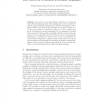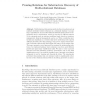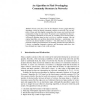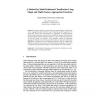PKDD
2007
Springer
14 years 9 months ago
2007
Springer
Collaborative tagging systems allow users to assign keywords—so called “tags”—to resources. Tags are used for navigation, finding resources and serendipitous browsing and ...
PKDD
2007
Springer
14 years 9 months ago
2007
Springer
PKDD
2007
Springer
14 years 9 months ago
2007
Springer
Multirelational data mining methods discover patterns across multiple interlinked tables (relations) in a relational database. In many large organizations, such a multi-relational ...
PKDD
2007
Springer
14 years 9 months ago
2007
Springer
Randomized Response techniques have been empirically investigated in privacy preserving association rule mining. However, previous research on privacy preserving market basket data...
PKDD
2007
Springer
14 years 9 months ago
2007
Springer
Recent years have seen the development of many graph clustering algorithms, which can identify community structure in networks. The vast majority of these only find disjoint commun...
PKDD
2007
Springer
14 years 9 months ago
2007
Springer
In this paper, a method for automatic classification of Hidden-Web databases is addressed. In our approach, the classification tree for Hidden Web databases is constructed by tailo...
PKDD
2007
Springer
14 years 9 months ago
2007
Springer
Frequent itemset mining assists the data mining practitioner in searching for strongly associated items (and transactions) in large transaction databases. Since the number of frequ...
PKDD
2007
Springer
14 years 9 months ago
2007
Springer
This paper presents a novel method for multi-relational classification via an aggregation-based Inductive Logic Programming (ILP) approach. We extend the classical ILP representati...
PKDD
2007
Springer
14 years 9 months ago
2007
Springer
Abstract. This paper shows how multi-dimensional functions, describing the operation of complex equipment, can be learned. The functions are points in a shape space, each produced ...
PKDD
2007
Springer
14 years 9 months ago
2007
Springer
A relevance filter is proposed which removes features based on the mutual information between class labels and features. It is proven that both feature independence and class condi...




